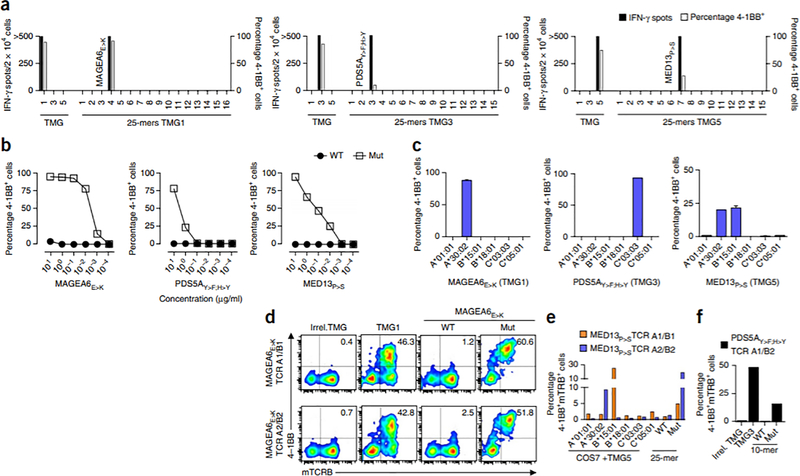Figure 2.
Characterization of neoantigen-specific lymphocytes isolated from the circulating CD8+PD1+ subset of subject NCI-3998. (a–c) Reactivity of TMG1- (left), TMG3- (middle) and TMG5-reactive (right) lymphocytes to the indicated TMGs or to the individual mutant 25-mers encoded by the indicated TMG (a), serial dilutions of the wild-type (WT) or mutant (Mut) MAGEA6E>K, PDS5AY>F;H>Y and MED13P>S minimal peptides (b), and COS7 cells cotransfected with the corresponding constructs expressing the indicated TMG and the individual HLA alleles that encode the HLA class I molecules indicated on the x axis (such as HLA-A*01:01; denoted A*01:01) (c). In c, the mean ± s.d. is plotted. (d–f) Reactivity of autologous PBMC that were transduced with retroviruses encoding neoantigen-specific TCRs. The T cell population of origin and the rank of the TRA and TRB sequences used to construct each TCR is denoted (as ‘TCR (A rank number)/(B rank number)’). The constructed TCRs expressed mouse constant regions, enabling the detection of the TCR with antibodies specific for the mouse TRB constant region (mTRB). Analyses showing reactivity of two distinct MAGEA6E>K-specific TCRs to TMG1 and the WT and Mut MAGEA6E>K minimal epitopes (CD3+CD8+ cells are plotted and the percentage of mTRB+4–1BB+ cells is shown) (d), mutant neo-epitope recognition and HLA restriction of two different MED13P>S-specific TCRs (e), and reactivity of a PDS5AY>F;H>Y-specific TCR to TMG3 and to the WT and Mut PDS5AY>F;H>Y peptides (f). Unless otherwise specified, experiments were performed without duplicates. All data are representative of at least two experiments.

